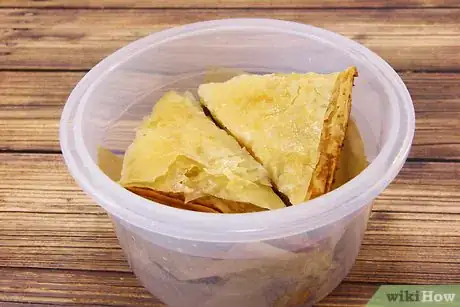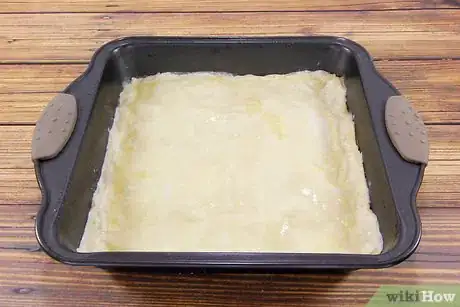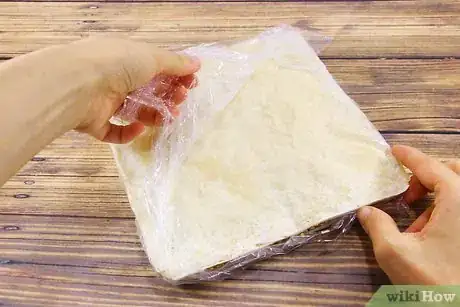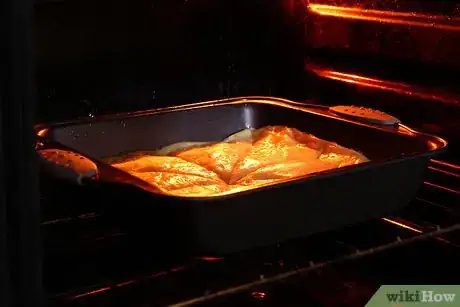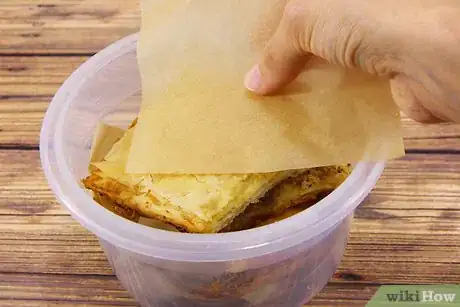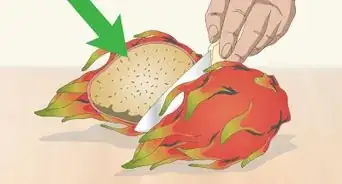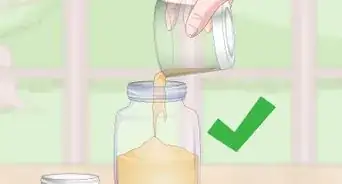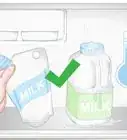This article was co-authored by wikiHow Staff. Our trained team of editors and researchers validate articles for accuracy and comprehensiveness. wikiHow's Content Management Team carefully monitors the work from our editorial staff to ensure that each article is backed by trusted research and meets our high quality standards.
This article has been viewed 39,658 times.
Learn more...
Although baklava originated in the Middle East, it won over the tastes of people around the world with its layers of filo held together by honey or syrup. And with its relatively long shelf-life, it can be stored and enjoyed months after baking. Whether you're storing leftover baklava or you want to freeze it before it's baked, there are a few ways to ensure it retains all of its delicious flavors.
Steps
Storing Baked Baklava at Room Temperature
-
1Cool your baklava at room temperature before storing it. Remove your baklava from the oven and it into a wide, shallow, and uncovered container. Cooling is especially important when the weather is rainy or humid.[1]
- During the summer, cool your baklava in the refrigerator immediately after baking it. This gives them time to cool before exposing it to room temperature conditions.
- Don't store your baklava at room temperature for more than 5 days.[2]
-
2Cut your baklava into triangular pieces. Place your baklava into a pan and cut it into squares or rectangles. Afterward, cut across each piece diagonally to create triangular pieces.[3]
- Pour your favorite syrup over the baklava after cutting them. You can also wait until you are ready to eat them to do so.
- Let your baklava sit for 5 minutes before eating.
Advertisement -
3Layer 4 to 6 pieces of baklava with pieces of parchment paper. Place 2 pieces of baklava onto parchment paper. Afterward, place another piece of parchment paper on top, and add another 2 pieces of baklava on top. Finally, top off the batch with another 2 baklava pieces, and place a final piece of parchment paper on top.
- Limit your batches to 4 to 6 baklava pieces so you don't have to defrost all of them at once.
- Always separate each layer with a piece of wax or parchment paper.
-
4Place your batch of baklava pieces into an airtight container. Take your baklava layers and place them gently in a container. If you're using a container like a cookie tin, wrap a layer of aluminum foil around your baklava pieces to prevent damage. Don't crowd the container. If the baklava doesn't fit, take out 1 or 2 pieces or try a different kind of container.[4]
- Mark the date onto the container or bag.
- Avoid ceramic containers—their porous nature lets air inside, which can accelerate aging.
-
5Store your baklava at room temperature or in the fridge for up to 2 weeks. After making sure the container is completely closed, store it somewhere cool in your kitchen or in the refrigerator. Test your baklava regularly using a food thermometer. Be sure that it doesn't rise above room temperature.[5]
- Keep your baked baklava at room temperature if you like a crispy texture.
- Store your baklava in the refrigerator if you like a chewy texture.
Freezing Unbaked Baklava
-
1Place your uncut baklava onto a baking pan lined with parchment paper. Line a baking pan with an equally sized piece of parchment paper. Gently place your unbaked baklava onto the pan. Take care not to break it apart.[6]
- If you don’t have parchment paper, grease your baking pan with 1⁄2 to 1 tablespoon (7.4 to 14.8 mL) of olive oil.
-
2Freeze your baklava for 3 to 4 hours. Place the uncovered baking pan into the freezer. Check on your baklava every hour or so. Gently touch it with your finger to determine if it is frozen. Once the baklava is completely frozen, remove the pan from the freezer.
-
3Wrap the baklava in 4 layers of plastic wrap and refreeze. Remove the pan from the freezer. Gently lift the baklava from the parchment paper and wrap it in 4 layers of plastic wrap. Place the plastic wrapped baklava back onto the pan and into the freezer for up to 4 months.[7]
- Throw out the parchment paper after removing the baklava.
-
4Defrost the baklava before cooking it. When you're ready to cook your baklava, remove it from the freezer and take off the wrap. Afterward, place it on the pan and put it into the refrigerator for about 1 hour.[8]
- You can also leave the baklava on the counter at room temperature for about 1 hour to thaw it. However, this is less ideal, especially in humid conditions.
-
5Bake your baklava at 325 °F (163 °C) for 30 to 35 minutes. After defrosting your baklava, butter the sides and bottom of a baking pan with a cooking brush. Afterward, place your baklava onto the pan and brush the top with butter. Cut the baklava into squares or rectangles, and then cut across them diagonally to create triangles.[9]
- Pour your choice of syrup over the baklava after removing them from the oven.
- Let your baklava sit for 5 minutes before eating.
Storing Baked Baklava in the Freezer
-
1Refrigerate your baklava in a shallow, wide container. Place all your baked baklava into a shallow, wide container right after they get out of the oven. Afterward, place the uncovered container into the refrigerator to cool. If you put your baklava right into the freezer, it will decrease the temperature of other foods items, which can ruin their taste and texture.[10]
- Freezer-safe bags also work. Just be careful that your baklava doesn't get crushed by other foods in your fridge.
-
2Layer 4 to 6 baklava pieces in a freezer-safe container. Place 2 pieces at the bottom of the container. Afterward, place a layer of parchment paper on top. Continue this process until the container is full and top it off with a final piece of parchment paper.
- Keep your batches to 4 to 6 baklava pieces. This lets you defrost them in small batches instead of all at once.
- Be sure to keep each layer separated with a piece of wax or parchment paper.
-
3Freeze your baklava for up to 4 months. Put your batch of baklava into the freezer until you want to reheat them. Once it's time to eat them, put them in the refrigerator for 4 to 6 hours or overnight to thaw.[11] .
Things You'll Need
- Airtight containers
- Freezer-safe containers
- Parchment paper
- Food thermometer
- Baking sheet
- Olive oil
- Labels
References
- ↑ https://www.cookinglight.com/cooking-101/techniques/how-to-freeze-foods#chill-food-before-freezing
- ↑ https://www.foodnetwork.com/recipes/alton-brown/baklava-recipe-1943974
- ↑ https://www.simplyhealthyfamily.org/how-to-store-baklava/
- ↑ https://www.craftsy.com/cooking/article/baklava/
- ↑ https://www.craftsy.com/cooking/article/baklava/
- ↑ https://www.oliviersandco.com/cooking-with-oil
- ↑ https://www.craftsy.com/cooking/article/baklava/
- ↑ https://www.simplyhealthyfamily.org/how-to-store-baklava/
- ↑ https://www.simplyhealthyfamily.org/how-to-store-baklava/



